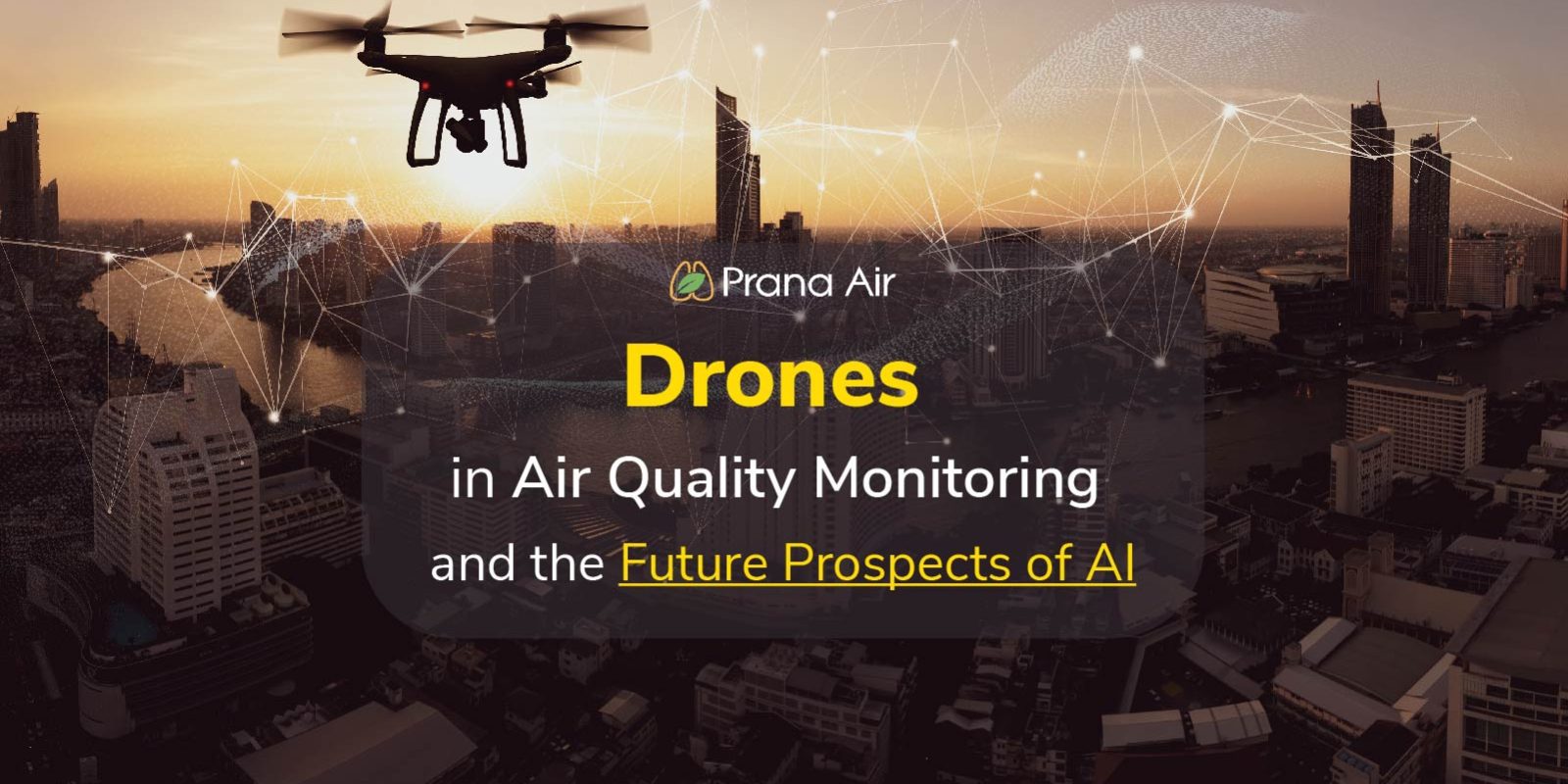In the past few years, there has been a rising recognition of the deteriorating air quality and its detrimental effects on human health. Consequently, there has been a notable advancement in the field of air quality monitoring through the utilization of drones. Equipped with advanced and precise sensors, these drones have the capability to monitor air quality indicators with great accuracy. Furthermore, drones provide the added benefit of monitoring air quality in areas that would otherwise require significant resources to establish physical monitoring stations. As drone technology continues to progress, there is an exciting opportunity to explore the integration of AI in air quality monitoring and its potential applications. Now, let’s delve deeper into this subject.
Introduction
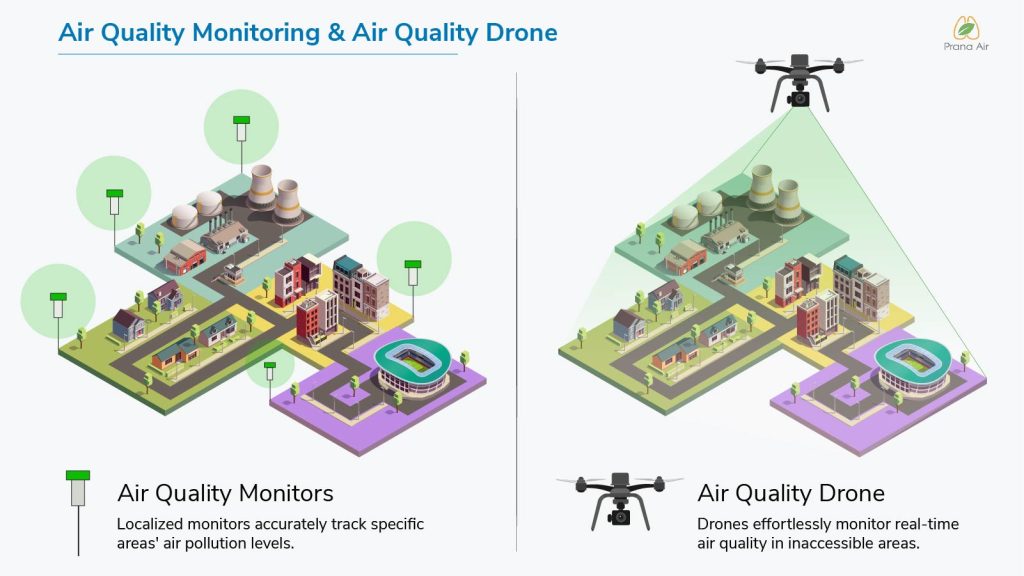
The process of air quality monitoring entails collecting data on the composition of the air and analyzing it to detect various pollutants and their concentrations in the atmosphere. Traditional approaches predominantly relied on stationary monitoring stations, but they had drawbacks in terms of limited coverage and flexibility. However, with advancements like drones, we now have the capability to remotely evaluate air quality in multiple locations. What’s more, air quality drones are creating exciting prospects in areas where setting up traditional monitoring stations is not feasible. With these technological advancements, we are embracing new opportunities to understand and address air pollution more effectively.
Air Quality Drones: Advantages
Improved Movement and Adaptability
Compared to traditional monitoring stations, drones provide unparalleled mobility. They can be deployed to specific areas of interest, offering real-time data on air quality across different locations. This exceptional flexibility enables comprehensive monitoring, even in challenging or dangerous environments that are difficult to access.
Cost-efficiency
When it comes to environmental monitoring, drones present a cost-effective alternative to establishing and operating fixed monitoring stations. They have the capability to efficiently cover expansive regions, thereby reducing the requirement for numerous stationary stations. Additionally, drones can be equipped with multiple sensors, enabling simultaneous observations of multiple parameters. This versatility allows for comprehensive data collection in a single flight.
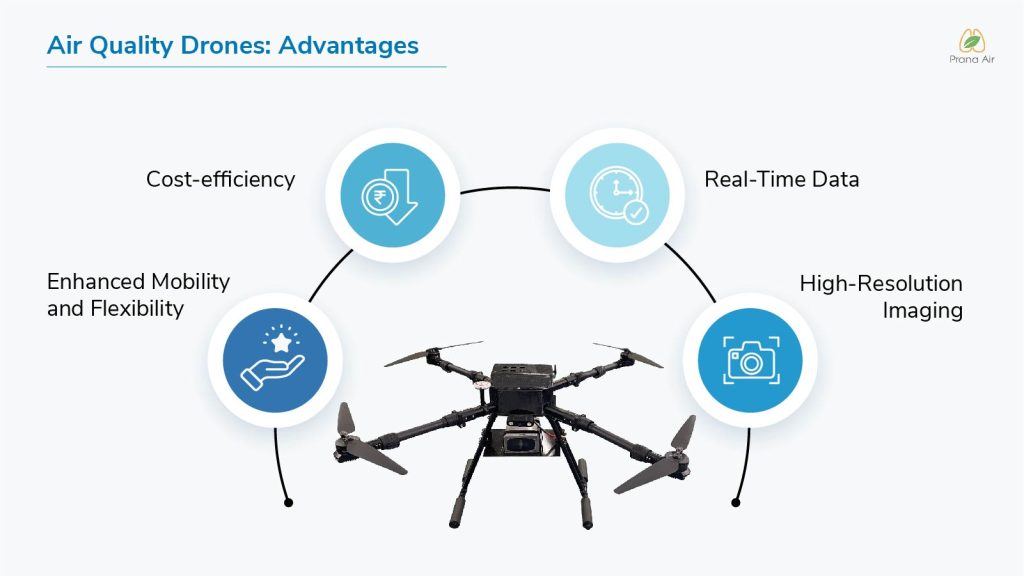
Real-Time Data
Equipped with exceptionally accurate and precise sensors, drones have the capability to collect real-time data on a wide range of air quality indicators. These indicators encompass parameters such as PM2.5, PM10, NO2, SO2, NH3, O3, CO, and more. The availability of real-time data facilitates swift response times, empowering authorities to promptly address any potential air pollution concerns.
High-Resolution Imaging
In addition to gathering air quality data, drones possess the ability to capture high-definition images and videos. These visual assets play a crucial role in identifying pollution sources, monitoring industrial emissions, and evaluating the overall environmental impact of specific activities. The integration of aerial imagery with air quality data offers a comprehensive understanding of the situation at hand.
AI in Air Quality Monitoring
The integration of AI with air quality monitoring in drones leads to a notable enhancement in their capabilities. AI algorithms are adept at efficiently analyzing the vast amount of data collected by drones, providing valuable insights to support decision-making processes. Here are several notable applications of AI in this field:
Analysing Data and Pattern Recognition
By employing AI algorithms, the air quality data obtained through drone monitoring can be extensively analyzed to detect patterns and anomalies. AI can effectively identify pollution hotspots, trace pollution sources, and monitor temporal changes. Moreover, AI insights play a crucial role in developing efficient methods for air quality management. Leveraging the capabilities of AI empowers decision-makers to gather valuable information, enabling them to formulate targeted and effective strategies to address and mitigate air pollution challenges. This utilization of AI equips decision-makers with the necessary tools to make informed choices, leading to impactful solutions in combatting air pollution.
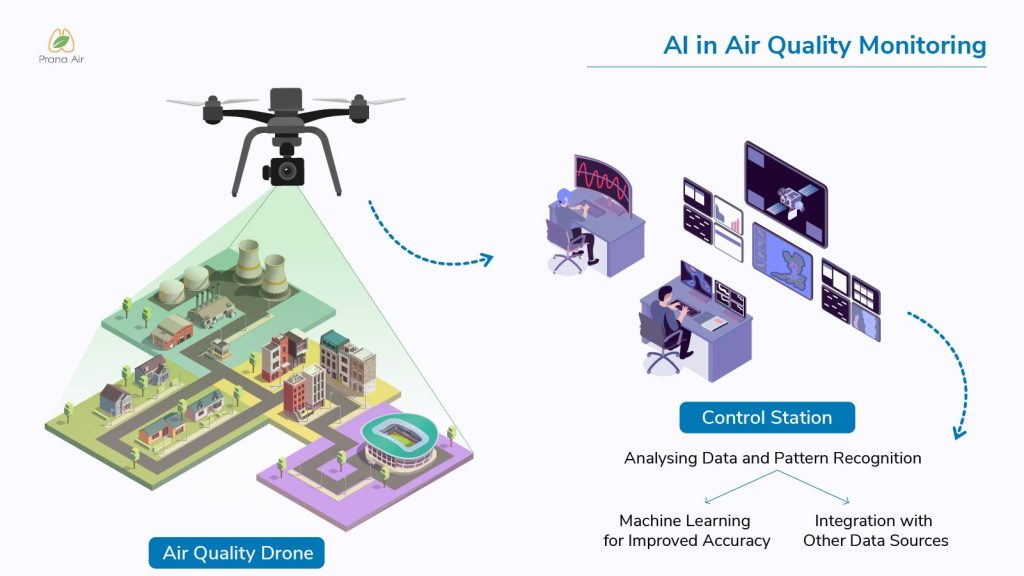
Models based on Predictions and Forecasts
By leveraging historical data and considering various environmental factors, AI can be employed to develop predictive models that forecast air pollution levels. These models utilize AI algorithms to analyze past data patterns and incorporate relevant variables such as weather conditions, geographical factors, and human activities. These AI-driven models provide valuable insights for proactive planning and decision-making by anticipating future pollution levels. As a result, authorities and communities can take preemptive measures and mitigate potential risks to air quality. This proactive approach enables the implementation of preventive actions to safeguard and improve air quality conditions.
These models can assist in proactive decision-making, allowing authorities to implement preventive measures before air pollution reaches critical levels.
Integration with Other Data Sources
AI algorithms can integrate air quality data from drones with data from other sources. These include weather conditions, traffic patterns, or industrial activities. This holistic approach provides a complete understanding of the factors influencing air quality, facilitating more targeted and efficient interventions.
The Future Prospects of AI in Air Quality Monitoring
AI technology advancements are closely associated with the development and future of air quality monitoring. Following are some potential developments that hold promise for the future:
Independent Drone Networks
We are expecting the introduction of automated drone systems for air quality monitoring as AI continues to evolve. These networks would be made up of numerous drones working together to cover wider areas and collect more data. This collaborative effort also aims to achieve speedy and thorough environmental monitoring. Drones may ensure that the data they acquire is collected in the most efficient way possible by sharing data and coordinating their actions. This method improves the accuracy and scope of the obtained data, resulting in better insights and decision-making.
Machine Learning (ML) for Improved Accuracy
Machine Learning or ML algorithms are critical for improving the accuracy of air quality monitoring. By continuously assessing and learning from the collected data, AI systems can refine their models and improve their ability to detect patterns, identify pollution sources, and predict air pollution levels. This iterative learning process can lead to more accurate and reliable monitoring outcomes.
Integration with Smart City Initiatives
As the movement towards smart and sustainable cities gains traction, the integration of air quality monitoring drones seems increasingly probable. Equipped with AI-powered sensors, these drones can gather real-time data that easily integrate into urban infrastructure and decision-making systems. This integration further facilitates swift actions, such as optimizing traffic flow, adjusting industrial operations, or notifying residents of pollution spikes. By using these advanced technologies, cities can proactively address air quality concerns and ensure a healthier environment for their citizens.
Environmental Impact Assessments
Drones offer a multitude of advantages in air quality monitoring, including enhanced mobility, cost-effectiveness, real-time data collection, and high-resolution imaging capabilities. When combined with AI systems, drones become even more potent. AI analyzes the data collected by drones, identifies patterns, and generates predictions. However, the future holds even more promising prospects. We can anticipate the emergence of autonomous drone networks that leverage advancements in machine learning (ML) to achieve improved accuracy. These networks will seamlessly integrate with smart city initiatives and enable advanced environmental impact assessments. As we continue to harness the power of technology, air quality monitoring will become more efficient, proactive, and impactful, ultimately leading to a cleaner and healthier environment for all.
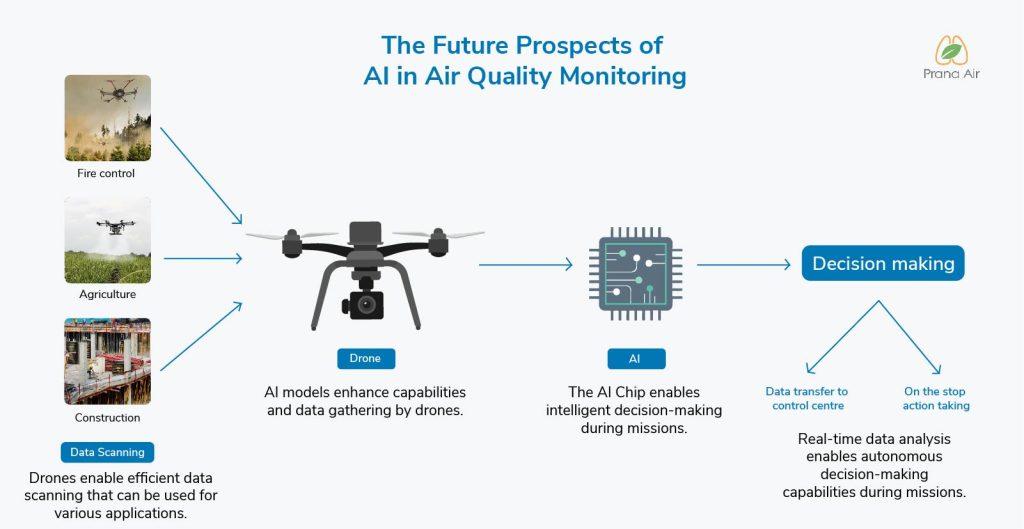
Conclusion
Drones offer numerous advantages in air quality monitoring, including enhanced mobility, cost-effectiveness, real-time data collection, and high-resolution imaging and videography capabilities. When combined with AI systems, drones become even more formidable. AI algorithms analyze the data collected by drones, identifying patterns and generating predictions. However, the future holds even more exciting prospects. We can expect the emergence of autonomous drone networks and improved accuracy through machine learning techniques. These advancements will also involve seamless integration with smart city initiatives and the implementation of advanced environmental impact assessments. As we continue to harness the power of technology, air quality monitoring will become increasingly efficient, proactive, and impactful. These advancements will contribute to creating a cleaner and healthier environment for everyone.

